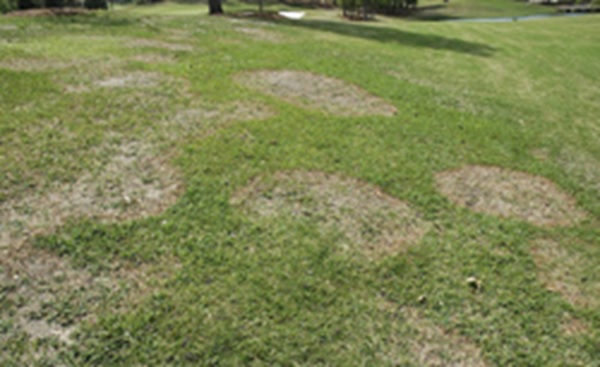Now is the time to plan for large patch
-
August 11, 2023
-
Share this article:
- SHARE:
By Lane Tredway, Ph.D., technical services manager for Syngenta
In the Southern and Midwestern United States, periods of cool, wet weather in late summer and fall can prompt large patch outbreaks on warm-season grasses. Zoysiagrass, centipedegrass and St. Augustinegrass are particularly susceptible to this disease, but bermudagrass can be affected as well.
Because large patch attacks when warm-season grasses are growing slowly and preparing for dormancy, its symptoms can linger until the following spring when growth resumes. Large patch weather tends to sneak up in late summer to early fall, so it pays to have a preventive plan in place to ensure applications are ready to go when needed.
When to apply for large patch control
Compendium™ fungicide is a new formulation with a combination of two active ingredients, azoxystrobin and propiconazole, developed specifically for lawn care operators (LCOs). These active ingredients work together to help protect turfgrasses from large patch and many other harmful diseases, including spring dead spot, leaf spot, dollar spot and rusts. Compendium is available in a compatible and easy-to-mix soluble concentrate (SC) formulation to deliver the power and flexibility that LCOs demand.
Syngenta also offers a variety of other products for large patch control, including sprayable formulations like Velista® and Heritage® fungicides and granular products like Headway® G and Heritage G fungicides. Two applications in the fall on a 28-day interval and one application in the spring at the rates recommended below can help provide effective large patch control:
| Product | Recommended Rate |
|---|
| Compendium | 2.6 fl. oz./1,000 ft.2 |
| Velista | 0.5 oz./1,000 ft.2 |
| Heritage 50WG | 0.4 oz./1,000 ft.2 |
| Heritage G | 4 lb./1,000 ft.2 |
| Headway G | 4 lb./1,000 ft.2 |
When to apply for large patch control
Effective prevention is essential when it comes to large patch, since the pathogen attacks when the turf is not growing optimally. For enhanced efficacy, timing should be based on soil temperature thresholds rather than calendar date. Pathogen activity begins in the late summer or early fall when soil temperatures dip below 70 F, and continues into the spring as long as soil temperatures are between 60 F and 70 F.
 Source: Syngenta, 2007. Wilmington, NC
Source: Syngenta, 2007. Wilmington, NCTo help you get the right timing for large patch prevention in your area, Syngenta has soil temperature maps and alerts available for soil-borne diseases like large patch, spring dead spot and more. You can view current and historical soil temperature data and sign up to receive email alerts when temperatures become favorable in your location.
For more information about large patch control,
contact your local Syngenta territory manager.
All photos are either the property of Syngenta or are used with permission.
© 2023 Syngenta. Important: Always read and follow label instructions. Some products may not be registered for sale or use in all states or counties. Please check with your local extension service to ensure registration and proper use. Compendium™, Headway®, Heritage®, Velista® and the Syngenta logo are trademarks of a Syngenta Group Company.